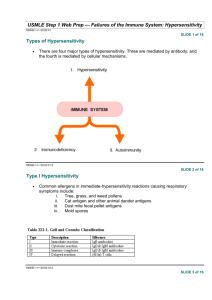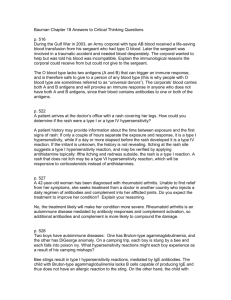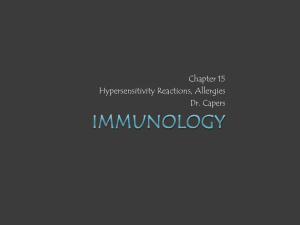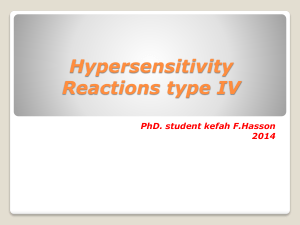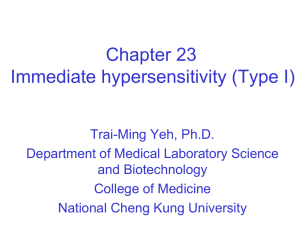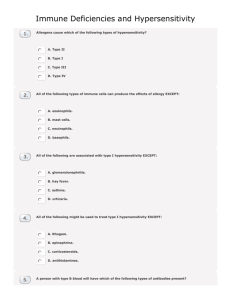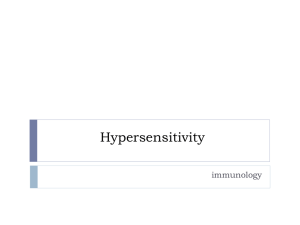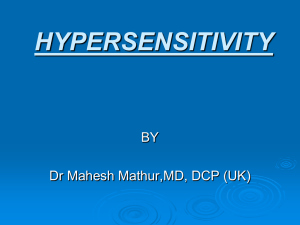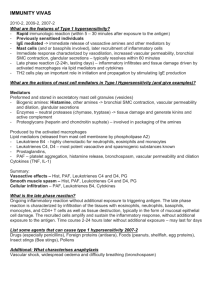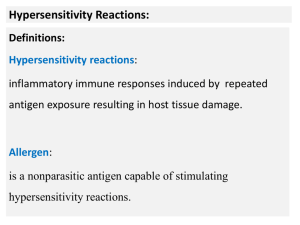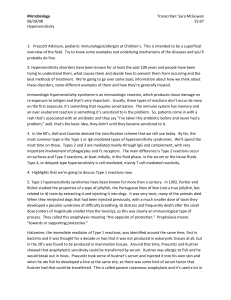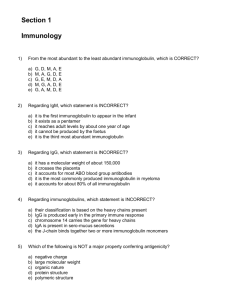Practice exam III
advertisement
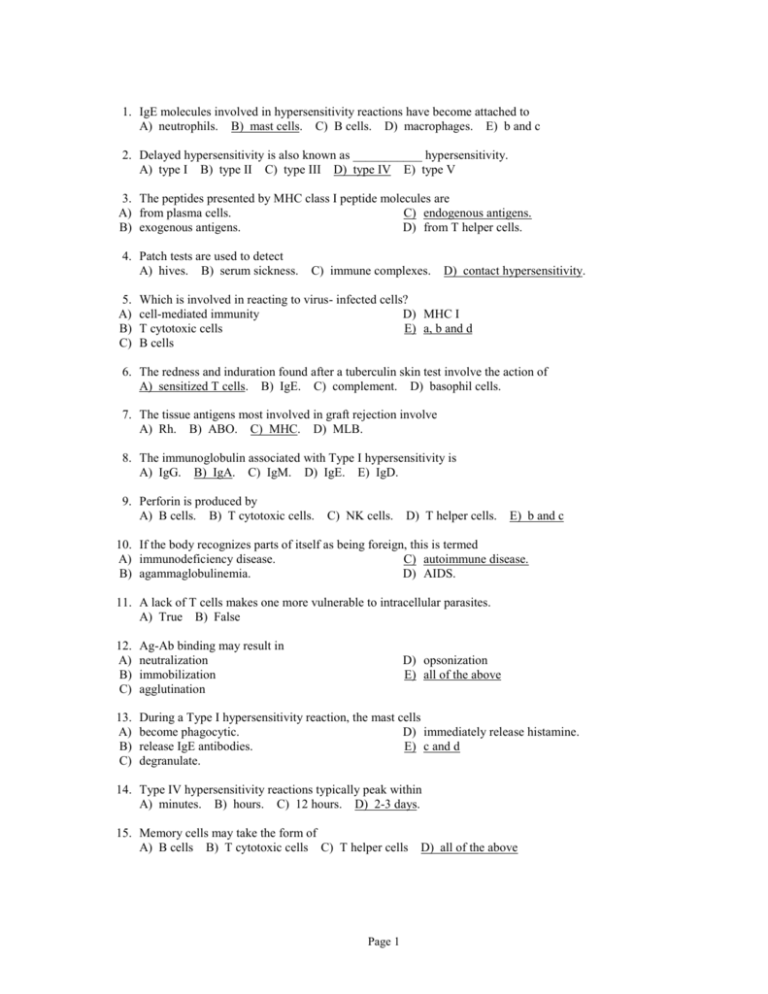
1. IgE molecules involved in hypersensitivity reactions have become attached to A) neutrophils. B) mast cells. C) B cells. D) macrophages. E) b and c 2. Delayed hypersensitivity is also known as ___________ hypersensitivity. A) type I B) type II C) type III D) type IV E) type V 3. The peptides presented by MHC class I peptide molecules are A) from plasma cells. C) endogenous antigens. B) exogenous antigens. D) from T helper cells. 4. Patch tests are used to detect A) hives. B) serum sickness. 5. A) B) C) C) immune complexes. D) contact hypersensitivity. Which is involved in reacting to virus- infected cells? cell-mediated immunity D) MHC I T cytotoxic cells E) a, b and d B cells 6. The redness and induration found after a tuberculin skin test involve the action of A) sensitized T cells. B) IgE. C) complement. D) basophil cells. 7. The tissue antigens most involved in graft rejection involve A) Rh. B) ABO. C) MHC. D) MLB. 8. The immunoglobulin associated with Type I hypersensitivity is A) IgG. B) IgA. C) IgM. D) IgE. E) IgD. 9. Perforin is produced by A) B cells. B) T cytotoxic cells. C) NK cells. D) T helper cells. E) b and c 10. If the body recognizes parts of itself as being foreign, this is termed A) immunodeficiency disease. C) autoimmune disease. B) agammaglobulinemia. D) AIDS. 11. A lack of T cells makes one more vulnerable to intracellular parasites. A) True B) False 12. A) B) C) Ag-Ab binding may result in neutralization immobilization agglutination 13. A) B) C) During a Type I hypersensitivity reaction, the mast cells become phagocytic. D) immediately release histamine. release IgE antibodies. E) c and d degranulate. D) opsonization E) all of the above 14. Type IV hypersensitivity reactions typically peak within A) minutes. B) hours. C) 12 hours. D) 2-3 days. 15. Memory cells may take the form of A) B cells B) T cytotoxic cells C) T helper cells Page 1 D) all of the above 16. Defects in bone marrow stem cells result in a condition known as A) SCID. B) AIDS. C) Di George's syndrome. D) Chediak-Higashi disease. 17. Generalized anaphylaxis is generally characterized by A) wheal and flare. B) inflammation. C) shock. D) rash. 18. A) B) C) D) E) Cyclosporin A is a relatively general immunosuppressive agent. suppresses T cell proliferation. activates macrophages. stimulates antibody production. a and b 19. A) B) C) The surface receptors on B and T cells both play the same role in each type of cell. bind to free antigen. have two binding sites for antigen. 20. A) B) C) Which of the following have been an effective immunosuppressant for use in transplantation? amphotericin B and cyclosporin A D) cephalosporin and amphotericin B FK506 and cephalosporin E) FK506 and amphotericin B cyclosporin A and tacrolimus D) have variable and constant regions. E) a and c. 21. Insulin-dependent diabetes mellitus is an example of an autoimmune disease that involves A) sensitized T cells. B) cytotoxic T cells. C) antibodies. D) IgD. 22. The cellular organelle responsible for the digestion of ingested infectious agents is the A) endoplasmic reticulum. B) Golgi apparatus. C) phagolysosome. D) lysosome. 23. The immunoglobulin that is important in hypersensitivity reactions is A) IgA. B) IgD. C) IgG. D) IgE. 24. A) B) C) D) E) Immune complexes consist of antigen-antibody bound together. are usually cleared rapidly from the body. bind to Fc receptors on cells. are involved in Type III hypersensitivity reactions. all of the above 25. All antigens are immunogens. A) True B) False 26. Anti-Rh antibodies may not cross the placenta. A) True B) False 27. Delayed type hypersensitivity primarily involves A) erythrocytes. B) B cells. C) T cells. D) mast cells. 28. A) B) C) Killing of graft cells occurs through a complex series of mechanisms including sensitized T cytotoxic cells . D) basophilic cells. NK cells. E) a and b erythrocytic cells. Page 2 29. The cluster of genes that are involved in the rejection of transplants is known as A) cluster of differentiation. C) antigenic determinant. B) epitope. D) major histocompatibility complex. 30. A) B) C) D) E) Apoptosis is a form of cell suicide. is induced in target cells by effector T cytotoxic cells. results in T cell death. refers to the transformation of B cells into plasma cells. a and b 31. The stimulation of B cells to divide and mature is provided by A) T helper cells. B) macrophages. C) T cytotoxic cells. D) plasma cells. 32. A) B) C) Graft-versus-host disease is primarily a Type I reaction. Type II reaction. Type III reaction. D) Type IV reaction. E) Type V reaction. 33. Secondary immunodeficiency disease is not the result of A) genetic defects. B) malignancies. C) advanced age. D) malnutrition. 34. Most cases of generalized anaphylaxis are a result of A) fire ant stings. C) bananas. B) aspirin. D) peanuts, bee stings or penicillin injections. 35. According to the clonal selection theory A) antibodies are modified, at the time of antigen exposure, to specifically react with the antigen. B) self-reactive T cells are killed in the thymus. C) B cells producing autoantibodies are eliminated in the thymus. D) each B cell is already programmed to produce a specific antibody. E) b and c 36. The immune response is directed against an entire molecule. A) True B) False 37. The type of hypersensitivity expressed with the lysing of red blood cells is A) Type I. B) Type II. C) Type III. D) Type IV. E) Type V. 38. CD4 cells are often A) T helper cells. B) T suppresser cells. C) T cytotoxic cells. D) T hypersensitivity cells. 39. Myasthenia gravis is an example of an autoimmune disease that involves A) sensitized T cells. B) cytotoxic T cells. C) antibodies. D) IgD. 40. T cells and B cells are manufactured in the A) bone marrow. B) thymus. C) Peyers patches. D) nervous tissue. 41. First exposure to an allergen results in a violent hypersensitivity reaction. A) True B) False Page 3 42. A) B) C) T-dependent antigens include polysaccharides. require the involvement of T cells. interact with MHCI molecules. D) are usually proteins. E) b and d 43. Gene rearrangement is responsible for the generation of the various antibody molecules. A) True B) False 44. A) B) C) Giant cells are a fusion of B cells. a fusion of T cells. used to contain bacterial infections. 45. A) B) C) D) E) HIV appears to cause AIDS. is an RNA virus. destroys T helper cells. makes the patient vulnerable to infections, especially those caused by opportunists. all of the above 46. A) B) C) D) E) Allografts are normally rejected within hours. are normally rejected within 10-14 days. are grafts between non-identical members of the same species. would include the fetus. b, c and d D) activated T helper cells. E) b and c 47. How long after initiation of a primary response do significant amounts of antibody appear in the blood? A) one day B) 10-14 days C) 4 weeks D) 6 months 48. The cell type responsible for Type II hypersensitivity is the A) mast cell. B) B cell. C) macrophage. D) platelet. 49. If a patient lacks B cells, the resulting disease is A) SCID. B) AIDS. C) Di George's syndrome. 50. A) B) C) Class II MHC molecules are found primarily on macrophages. dendritic cells. erythrocytes. Page 4 E) neutrophils D) agammaglobulinemia. D) T cytotoxic cells. E) a and b
